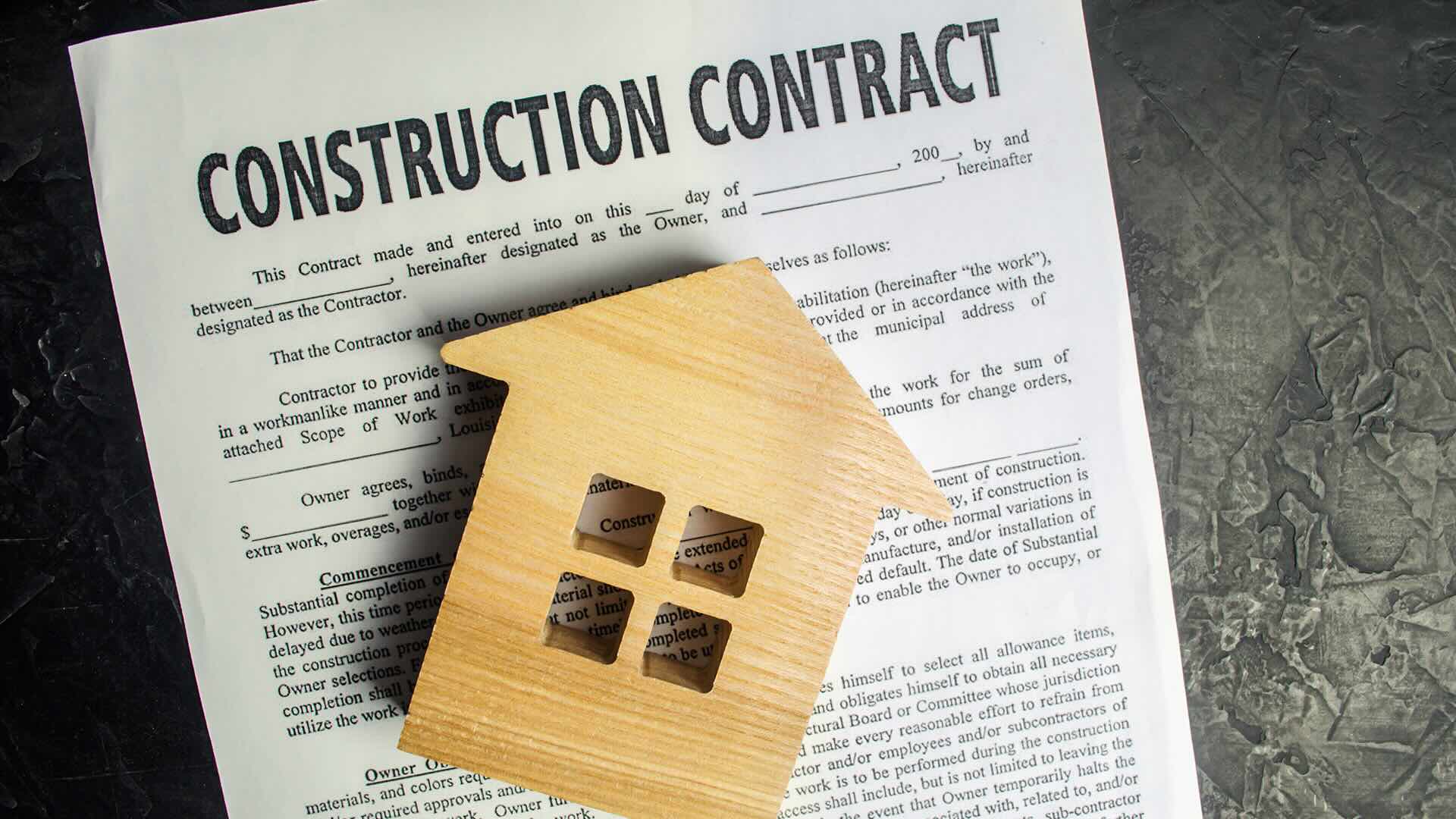Home>Garden Essentials>How To Find Landscape Design Contracts


Garden Essentials
How To Find Landscape Design Contracts
Modified: March 7, 2024
Looking for garden landscape design contracts? Learn how to find lucrative garden design contracts and grow your business.
(Many of the links in this article redirect to a specific reviewed product. Your purchase of these products through affiliate links helps to generate commission for Storables.com, at no extra cost. Learn more)
Introduction
Welcome to the world of landscape design contracts! As an aspiring landscape designer, finding contracts is crucial to building a successful business in the garden industry. Whether you are a seasoned professional looking to expand your client base or a newbie just starting out, this article will guide you on how to find landscape design contracts effectively.
Landscaping is not just about creating beautiful outdoor spaces; it is also a thriving business that offers countless opportunities for talented individuals like you. However, with the increasing competition in the market, it is essential to have a strategic approach to secure contracts and stand out from the crowd.
In this article, we will explore various methods and techniques for finding landscape design contracts. From conducting market research to building a strong portfolio, networking with the right people, attending trade shows, advertising online, collaborating with architects and contractors, and utilizing social media, we will cover it all. By the end of this article, you will have a comprehensive understanding of how to navigate the landscape design industry and successfully land contracts.
So, grab your gardening gloves, put on your thinking cap, and let’s dive into the exciting world of landscape design contracts!
Key Takeaways:
- Research your target market, competition, and industry trends to tailor your landscape design services and stand out. Building a strong portfolio and networking with industry professionals can help you secure lucrative contracts.
- Utilize online advertising, collaborate with architects and contractors, and consider bidding on government contracts to expand your client base and increase your chances of securing landscape design projects. Consistent effort and professionalism lead to success in the industry.
Read more: How To Get Landscaping Contracts
Researching the Market
Before diving into the landscape design business, it’s crucial to conduct thorough market research. Understanding the current trends, demands, and preferences of potential clients will give you a competitive edge and help you tailor your services to meet their needs.
Start by identifying your target market. Determine the demographic and psychographic characteristics of your ideal clients. Are you targeting residential homeowners, commercial properties, or both? Are you focusing on a specific geographic area or a particular niche within the landscaping industry?
Next, analyze the competition. Look at other landscape design businesses in your area and assess their strengths, weaknesses, and pricing strategies. This will give you insights into what sets you apart and how you can position yourself as a unique and desirable choice for clients.
Furthermore, research local regulations and requirements related to landscaping. Familiarize yourself with zoning laws, permits, and any specific guidelines that may impact your work. This will ensure that you operate within legal boundaries and can confidently address any concerns raised by potential clients.
Additionally, stay updated on the latest landscaping trends and innovations. Follow industry publications, attend workshops and conferences, and engage with online communities to stay informed about emerging techniques, sustainable practices, and design inspirations. Being knowledgeable about current trends will not only impress clients but also enable you to offer innovative solutions that align with their preferences.
Lastly, conduct a pricing analysis. Research the average rates charged by landscape designers in your area. Consider factors such as the complexity of projects, materials used, and your level of experience when determining your rates. Remember that pricing can significantly impact your competitiveness in the market, so find a balance between being affordable and reflecting the value you provide.
By conducting thorough market research, you will have a solid foundation for your landscape design business. Understanding your target market, competition, regulations, industry trends, and pricing will allow you to tailor your services and stand out from your competitors. So, invest time and effort into researching the market to ensure your success in the landscape design industry.
Building a Portfolio
A strong portfolio is a powerful tool for any landscape designer. It showcases your skills, creativity, and previous work to potential clients, giving them a glimpse of what they can expect when they hire you. Building an impressive portfolio is essential to attract landscape design contracts.
Here are some key steps to help you build a standout portfolio:
- Document Your Work: Start by documenting your previous landscape design projects. Take high-quality photographs of the completed projects, capturing different angles and details. If possible, include before-and-after pictures to demonstrate the transformation you achieved. Incorporate a variety of project types and styles to showcase your versatility.
- Showcase Your Expertise: Highlight your areas of expertise within the landscape design field. If you have expertise in sustainable gardening, water-wise landscaping, or designing outdoor entertainment spaces, make sure to include examples of projects that reflect this specialization.
- Provide Descriptions: Write brief descriptions for each project in your portfolio. Explain the design concept, challenges faced, and how you successfully addressed them. Mention any unique features or innovative techniques you incorporated. The descriptions should not only showcase your design skills but also demonstrate your ability to problem-solve and deliver successful projects.
- Create a Digital Portfolio: In today’s digital world, having an online presence is crucial. Create a professional website or online portfolio where you can showcase your work. Include high-quality images, project descriptions, and contact information. Make sure the website is visually appealing and easy to navigate, allowing potential clients to explore your designs effortlessly.
- Seek Client Testimonials: Request testimonials from previous clients to add credibility to your portfolio. Positive reviews and testimonials from satisfied customers can greatly influence potential clients’ decision-making process. Include these testimonials in your portfolio to demonstrate your professionalism, reliability, and ability to exceed client expectations.
- Continuously Update Your Portfolio: As you complete new landscape design projects, update your portfolio regularly. Keep it fresh and showcase your most recent work. This demonstrates that you are actively engaged in the industry and ensures that potential clients see your latest achievements.
Remember that your portfolio is a reflection of your skills and creativity as a landscape designer. Invest time and effort into curating an impressive portfolio that showcases your best work and highlights your unique style. A well-presented portfolio will significantly increase your chances of landing lucrative contracts and attracting clients who appreciate your design aesthetic.
Networking and Marketing
Networking and marketing are essential components of any successful landscape design business. By effectively promoting yourself and building professional connections, you can expand your client base and increase your chances of securing landscape design contracts. Here are some strategies to help you network and market your services:
- Attend Industry Events: Participate in landscape design conferences, trade shows, and workshops to connect with industry professionals. These events provide opportunities to showcase your work, gain inspiration, and establish valuable contacts. Engage in conversations, exchange business cards, and follow up with potential leads after the event.
- Join Professional Associations: Become a member of relevant industry associations, such as the Association of Professional Landscape Designers (APLD) or the American Society of Landscape Architects (ASLA). These associations offer networking events, educational resources, and promotional opportunities, helping you build credibility and connect with potential clients.
- Collaborate with Other Professionals: Form partnerships with architects, contractors, and other professionals in the construction and design industry. Collaborating with these professionals can lead to referrals and joint project opportunities. Attend industry mixers and actively seek out partnerships that complement your services.
- Utilize Social Media: Leverage the power of social media platforms like Instagram, Facebook, and LinkedIn to showcase your work, engage with potential clients, and build your brand. Regularly post high-quality photos of your projects, share informative content, and actively engage with your audience through comments and messages.
- Offer Free Consultations or Workshops: Provide free consultations or workshops to demonstrate your expertise and attract potential clients. This not only gives you an opportunity to showcase your skills but also allows you to build trust and establish yourself as a knowledgeable professional.
- Build Relationships with Local Nurseries and Suppliers: Establish relationships with local nurseries and suppliers in your area. They often have connections with homeowners, contractors, and developers who require landscape design services. By getting involved with these businesses, you can increase your visibility and gain access to potential clients.
- Ask for Referrals: Don’t be shy about asking your satisfied clients for referrals. Word-of-mouth recommendations are powerful in the landscaping industry. Offer incentives such as discounts or free services for referrals that result in signed contracts, further motivating your clients to refer you to their friends and acquaintances.
Remember, networking and marketing are ongoing efforts. Consistently put yourself out there, attend industry events, and stay active on social media. Building relationships and promoting your services will help you expand your professional network and increase your chances of finding landscape design contracts.
Attending Trade Shows and Events
Trade shows and industry events are excellent opportunities for landscape designers to network, showcase their work, and connect with potential clients. Attending these events can greatly enhance your visibility in the industry and increase your chances of securing landscape design contracts. Here’s how you can make the most of trade shows and events:
- Research and Plan: Before attending a trade show or event, research the exhibitors and speakers who will be present. Identify those who may be potential clients or collaborators. Plan your schedule and make a list of booths or sessions you want to visit.
- Create an Eye-catching Display: Set up a visually appealing booth that represents your brand and showcases your best work. Use high-quality imagery, informational brochures, and samples of materials or plants to engage attendees and spark their interest.
- Engage with Attendees: Be proactive in engaging with attendees who visit your booth. Smile, offer a friendly greeting, and initiate conversations about their landscaping needs or interests. Actively listen to their concerns and use this opportunity to showcase your expertise and explain how your services can address their specific requirements.
- Demonstrate Your Expertise: Consider giving live demonstrations or mini-workshops at your booth to showcase your skills and knowledge. This can involve creating a small display garden, demonstrating a design technique, or offering insightful tips and advice. Position yourself as an industry expert who is willing to share valuable information with potential clients.
- Collect Contact Information: Have a system in place to collect the contact information of interested attendees. This could be through digital forms, a signup sheet, or a business card collection box. Follow up with these leads after the event to nurture potential client relationships.
- Attend Workshops and Presentations: Take advantage of the educational workshops and presentations offered at trade shows and events. Expand your knowledge, gain insights from industry experts, and stay up to date with the latest trends and practices. This will not only benefit your own professional growth but also provide opportunities to connect with fellow professionals and potential clients.
- Network with Other Exhibitors: Engage with other exhibitors and professionals in the industry. Forming connections with fellow landscape designers, suppliers, contractors, and architects can open doors to potential collaborations and referrals. Attend networking events, trade show after-parties, and social gatherings to build relationships and expand your professional network.
Attending trade shows and events is a valuable investment of your time and resources. It allows you to showcase your work, connect with potential clients, stay updated on industry trends, and network with other professionals. Be prepared, engage with attendees, and make the most of these opportunities to increase your visibility and secure landscape design contracts.
Read more: How To Write Up A Landscaping Contract
Advertising Online
In today’s digital age, advertising online is crucial for reaching a wide audience and attracting potential clients. Implementing effective online advertising strategies can significantly increase your visibility and help you secure landscape design contracts. Here are some online advertising techniques to consider:
- Create a Professional Website: A well-designed website is essential for establishing your online presence. Ensure that your website is visually appealing, easy to navigate, and mobile-friendly. Include your portfolio, services offered, contact information, and testimonials from satisfied clients.
- Optimize for Search Engines: Implement search engine optimization (SEO) strategies to improve your website’s visibility in search engine results. Use relevant keywords in your website content, meta tags, and headers. Publish blog posts and articles that offer valuable information and tips related to landscaping to attract organic traffic to your site.
- Utilize Pay-Per-Click (PPC) Advertising: Pay-per-click advertising is a popular method for driving targeted traffic to your website. Platforms like Google Ads allow you to create ads that appear when users search for relevant keywords. Set a budget, choose specific keywords, and create compelling ad copy to attract potential clients.
- Utilize Social Media Advertising: Social media platforms like Facebook and Instagram offer powerful advertising options to target specific audiences. Create visually appealing ads that showcase your work and target users based on location, interests, and demographics.
- Utilize Google My Business: Google My Business is a free tool that allows you to create and manage your business profile on Google. It helps you appear in local search results, display your contact information and opening hours, and receive client reviews. Regularly update your profile and engage with client reviews to build trust and credibility.
- Utilize Online Directories: List your business on online directories specific to the landscaping or home improvement industry. This can significantly increase your online visibility and make it easier for potential clients to find you when searching for landscape design services.
- Create Engaging Content: Develop a content marketing strategy that includes creating informative and engaging content related to landscaping. Publish blog posts, videos, or podcasts that showcase your expertise and provide valuable tips and insights. Share this content on your website and social media channels to attract and engage with your target audience.
- Engage with Online Communities: Participate in online forums, groups, and social media communities related to gardening and landscaping. Answer questions, offer advice, and establish yourself as a helpful expert in the field. This will attract potential clients who are seeking professional guidance and increase your credibility.
When advertising online, be consistent with your branding, maintain a professional tone, and focus on showcasing the value you provide as a landscape designer. By implementing these online advertising strategies, you can effectively promote your business, increase your online visibility, and attract potential clients to secure landscape design contracts.
One tip for finding landscape design contracts is to network with local real estate agents, property managers, and construction companies. They often have clients in need of landscaping services.
Collaborating with Architects and Contractors
Collaborating with architects and contractors is an excellent strategy for expanding your network and securing landscape design contracts. Working together with these professionals allows you to tap into new opportunities, leverage their existing client base, and offer comprehensive solutions to clients. Here’s how you can effectively collaborate with architects and contractors:
- Build Relationships: Start by building relationships with architects and contractors in your area. Attend industry events, join professional associations, and actively participate in networking opportunities. Take the time to get to know these professionals and understand their areas of expertise.
- Showcase Your Work: Create a portfolio highlighting your best landscape designs. Include before-and-after photos, project descriptions, and testimonials from satisfied clients. Share this portfolio with architects and contractors to demonstrate your skills and the value you can bring to their projects.
- Offer Value: Show architects and contractors how collaborating with you can benefit their projects. Emphasize that your expertise in landscape design can complement and enhance their work. Highlight how a well-designed outdoor space can enhance the overall aesthetics and functionality of a building or property.
- Establish a Referral System: Set up a referral system with architects and contractors, where you recommend each other’s services to clients. This mutually beneficial arrangement allows you to tap into their client base and vice versa. Ensure that the referral process is clear and transparent, and that both parties understand how it works.
- Offer Comprehensive Solutions: Present yourself as a one-stop solution for landscaping needs. Collaborate with architects and contractors to provide integrated design solutions that incorporate both the building’s structure and the surrounding outdoor space. Offer your expertise in selecting appropriate plants, hardscaping elements, and outdoor amenities that enhance the overall design concept.
- Communicate Effectively: When collaborating with architects and contractors, ensure clear and open lines of communication. Share project specifications, timelines, and goals. Regularly update each other on progress and address any challenges that arise. This level of collaboration and communication creates a seamless and efficient workflow.
- Maintain Professionalism and Respect: Respect the role and expertise of architects and contractors. Understand their design objectives and collaborate with them rather than trying to overshadow or dictate their work. By working together harmoniously, you create a positive environment and deliver exceptional results to clients.
Remember, collaboration with architects and contractors can significantly enhance your opportunities to secure landscape design contracts. By building strong relationships, showcasing your work, offering value, establishing referral systems, and providing comprehensive solutions, you can position yourself as a trusted collaborator and attract more clients in the process.
Joining Professional Associations
Joining professional associations is a valuable step for landscape designers looking to enhance their credibility, expand their network, and secure landscape design contracts. These associations offer numerous benefits, including educational opportunities, networking events, and access to industry resources. Here’s why you should consider joining professional associations:
- Credibility and Trust: Being a member of a recognized professional association adds credibility to your name and reputation. Clients see membership as a sign of commitment to professional standards and ongoing education. It instills trust in potential clients, making them more likely to choose your services over competitors who are not associated with any professional organization.
- Networking Opportunities: Professional associations provide networking opportunities where you can connect with fellow landscape designers, industry experts, and potential clients. Attend association events, conferences, and workshops to meet like-minded individuals, learn from their experiences, and establish valuable connections. Networking within the association can lead to collaborations, referrals, and new business opportunities.
- Access to Resources: Many professional associations offer access to a wealth of resources, including industry publications, research papers, design guidelines, and legal and technical support. These resources can help you stay updated with industry trends, expand your knowledge, and provide valuable insights to clients.
- Continuing Education: Professional associations often offer continuing education programs, workshops, and webinars. These opportunities allow you to enhance your skills, learn about the latest techniques and trends, and stay relevant in a constantly evolving industry. Continuing education not only benefits your professional growth but also serves as a competitive advantage in attracting clients who value ongoing learning.
- Advocacy and Representation: Professional associations advocate for the interests of their members and the industry as a whole. They work to shape policies, regulations, and standards that impact the profession. By joining an association, you contribute to the collective voice and help shape the future of the landscape design industry.
- Recognition and Awards: Many professional associations offer awards and recognition programs that celebrate outstanding achievements in the industry. Participating in these programs can elevate your profile, increase your visibility, and provide valuable marketing opportunities to attract new clients.
- Professional Development: Associations often provide opportunities for leadership roles, committee involvement, and volunteer positions. Engaging in these activities allows you to develop valuable skills, expand your industry knowledge, and contribute to the growth and advancement of the profession.
When choosing which professional association to join, consider factors such as the association’s focus, reputation, membership benefits, and alignment with your professional goals. Research different associations in the landscaping industry, such as the Association of Professional Landscape Designers (APLD) or the American Society of Landscape Architects (ASLA), and select one that best suits your needs.
By joining a professional association, you not only gain credibility and access to valuable resources but also become part of a supportive community that can help you navigate the landscape design industry. Take advantage of the opportunities these associations offer, and use them to grow your network and secure landscape design contracts.
Utilizing Social Media
Social media has revolutionized the way we connect, communicate, and promote our businesses. As a landscape designer, leveraging social media platforms can play a significant role in expanding your reach, attracting clients, and securing landscape design contracts. Here’s how you can effectively utilize social media for your business:
- Choose the Right Platforms: Determine which social media platforms are most relevant to your target audience. Facebook, Instagram, and LinkedIn are popular choices for landscape designers. Facebook allows you to engage with a broad audience, while Instagram emphasizes visual content. LinkedIn is ideal for establishing professional connections.
- Create a Compelling Profile: Craft a captivating and informative profile for your business on each social media platform you use. Use high-quality images of your work, write a compelling bio, and include relevant contact information, such as your website and email address. Optimize your profiles with relevant keywords to enhance discoverability.
- Showcase Your Work: Share photos and videos of your landscape design projects on social media. Highlight different aspects of your work, such as before-and-after transformations, design details, and unique features. Engage your audience by providing insights into your design process or sharing “behind-the-scenes” content.
- Provide Valuable Content: Offer informative and engaging content related to gardening and landscaping. Share tips, DIY ideas, seasonal trends, and design inspirations that are relevant to your target audience. By sharing valuable content, you position yourself as an expert and attract followers who appreciate your knowledge and expertise.
- Engage with Your Audience: Actively engage with your followers by responding to comments, messages, and inquiries in a timely manner. Show appreciation for positive feedback and address any concerns or questions raised by your audience. Building genuine connections fosters trust and loyalty, increasing the likelihood of securing landscape design contracts.
- Collaborate and Tag Relevant Accounts: Collaborate with other professionals in the industry, such as architects, contractors, and suppliers. Tagging their accounts in your posts can expand your reach to their followers and increase your visibility. Similarly, participate in relevant hashtags and engage with accounts that align with your brand to further expand your network.
- Run Social Media Ads: Consider running targeted advertisements on social media platforms. Narrow down your audience based on demographics, interests, and location to reach potential clients who are interested in landscaping services. Create visually appealing ads that drive traffic to your website or encourage users to contact you for inquiries.
- Showcase Client Testimonials: Share testimonials and reviews from satisfied clients on your social media platforms. This adds credibility and proof of your excellent work. Ask clients for permission to share their testimonials and accompany them with photos of the corresponding project to strengthen the impact.
- Monitor and Analyze Metrics: Make use of the analytics tools provided by social media platforms to monitor the performance of your posts and ads. Track metrics such as engagement rates, reach, and conversions to identify the types of content that resonate with your audience. This data will help you refine your social media strategy for optimal results.
Consistency is key when utilizing social media for your landscape design business. Regularly update your profiles, share engaging content, interact with your audience, and analyze the results. By strategically utilizing social media, you can build brand awareness, attract potential clients, and ultimately secure landscape design contracts.
Read more: How To Find A Landscaping Job
Bid on Government Contracts
One often overlooked avenue for securing landscape design contracts is bidding on government contracts. Government entities at the local, state, and federal levels frequently need landscape design services for public spaces, parks, schools, government buildings, and infrastructure projects. Here’s how you can successfully bid on government contracts:
- Research Government Contract Opportunities: Stay informed about government contract opportunities by regularly checking government websites, procurement portals, and local bid listings. These platforms provide information on upcoming projects, contract requirements, and submission deadlines.
- Understand Government Procurement Processes: Familiarize yourself with the specific procurement processes and regulations for government contracts. Each government agency may have its own guidelines, evaluation criteria, and documentation requirements. Understanding these processes will help you prepare and submit competitive bids.
- Identify Suitable Contracts: Evaluate available government contracts to determine which ones align with your expertise and capacity. Consider the project scope, budget, timeline, and any specialized requirements. Focus on contracts that match your skill set and experience to increase your chances of success.
- Prepare a Competitive Bid: Craft a well-structured and persuasive bid proposal that highlights your qualifications, relevant experience, and unique value proposition. Clearly articulate how your landscape design services will meet the government’s project objectives and deliver exceptional results. Be thorough and ensure all required documentation is included in your submission.
- Price Your Bid Competitively: Develop a pricing strategy that balances profitability with competitiveness. Research prevailing market rates for similar government projects in your area. Consider factors such as labor costs, materials, equipment, and any regulatory requirements that may impact pricing. Submit a competitive bid that reflects the value you provide while remaining within the government’s budget constraints.
- Follow Submission Guidelines: Pay close attention to the submission guidelines outlined in the government contract. Submit your bid in the requested format and within the specified deadline. Failure to adhere to the guidelines may result in disqualification.
- Build Relationships with Government Officials: Develop relationships with relevant government officials and procurement personnel. Attend government networking events, workshops, and industry conferences where you can connect with decision-makers. Building these relationships can provide insights into upcoming projects and increase your visibility within government circles.
- Consider Subcontracting Opportunities: If you’re just starting out or lack the resources to take on large-scale government contracts on your own, consider subcontracting opportunities. Partner with established landscape design firms that have experience working on government contracts. By joining forces, you can collectively bid on larger projects.
- Ensure Compliance and Quality: Government contracts often require strict compliance with regulations and quality standards. Familiarize yourself with relevant regulations, permits, and certifications that may be necessary for specific government projects. Demonstrating your commitment to compliance and delivering high-quality work will enhance your chances of success in obtaining government contracts.
Securing government contracts requires research, preparation, and a thorough understanding of the procurement process. By investing time in researching opportunities, crafting competitive bids, building relationships with government officials, and demonstrating compliance and quality, you can increase your chances of securing lucrative landscape design contracts from government entities.
Conclusion
Securing landscape design contracts requires a strategic approach and a combination of various techniques to stand out in a competitive industry. By following the steps outlined in this article, you can significantly improve your chances of finding and securing lucrative contracts. Here’s a brief recap of the strategies discussed:
- Conduct thorough market research to understand your target audience, competition, and industry trends.
- Build a strong portfolio that showcases your skills, expertise, and previous work.
- Network and market your services by attending trade shows, joining professional associations, and utilizing social media.
- Collaborate with architects and contractors to expand your network and offer comprehensive solutions to clients.
- Utilize online advertising strategies and effectively promote your business through websites, social media, and online directories.
- Consider bidding on government contracts as an additional avenue for securing landscape design projects.
Remember, success in the landscape design industry takes time and perseverance. Continuously enhance your skills, stay updated with industry trends, and strive to exceed client expectations. Building a solid reputation and providing exceptional service will lead to repeat business and word-of-mouth referrals.
With the right mix of research, networking, marketing, collaboration, and utilizing online platforms, you can position yourself as a successful landscape designer and secure landscape design contracts that will propel your business forward. Embrace the opportunities available in this exciting field, and enjoy the satisfaction of creating beautiful outdoor spaces for your clients.
Frequently Asked Questions about How To Find Landscape Design Contracts
Was this page helpful?
At Storables.com, we guarantee accurate and reliable information. Our content, validated by Expert Board Contributors, is crafted following stringent Editorial Policies. We're committed to providing you with well-researched, expert-backed insights for all your informational needs.














0 thoughts on “How To Find Landscape Design Contracts”